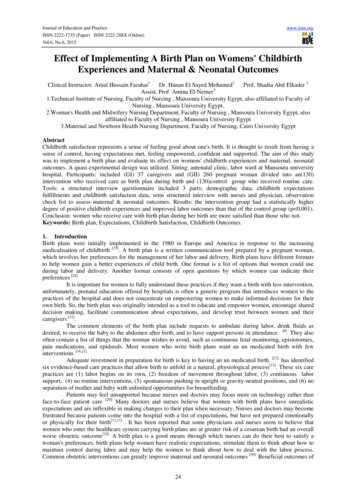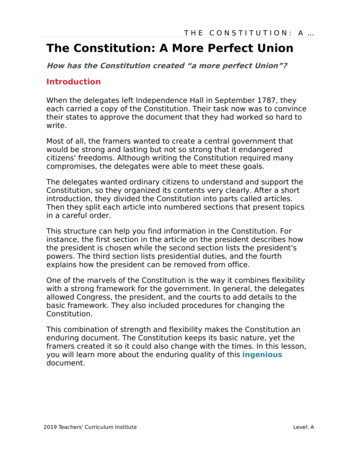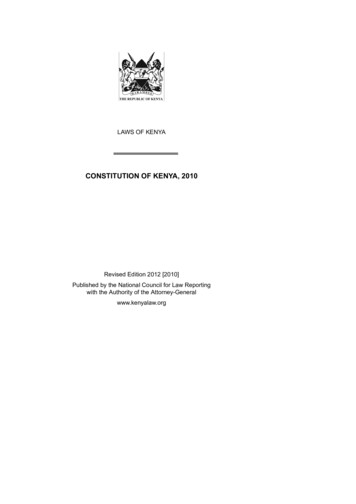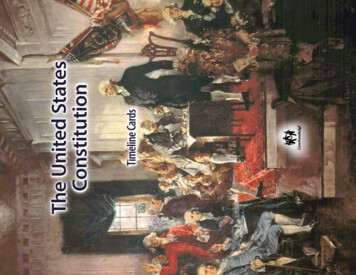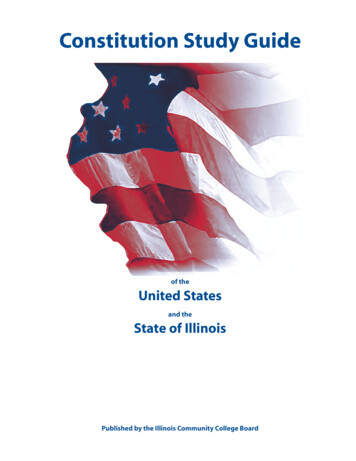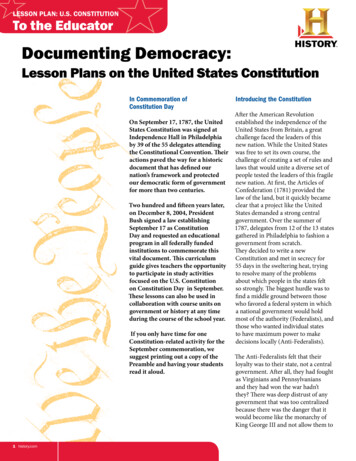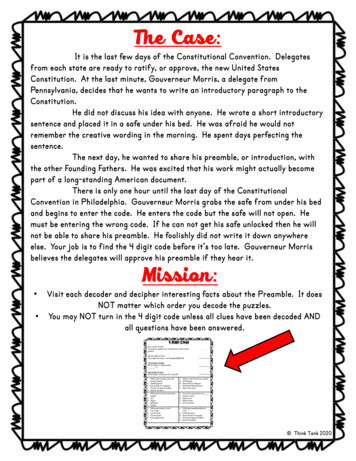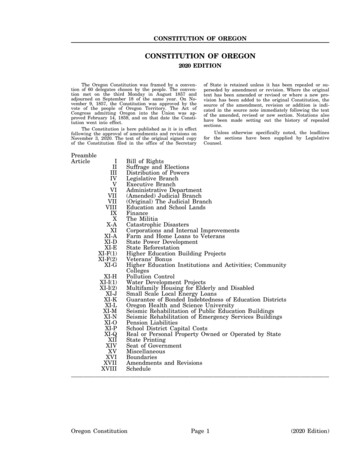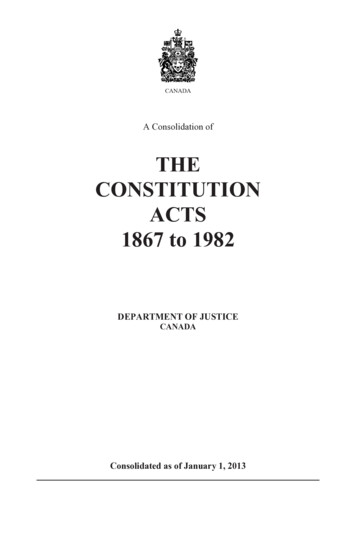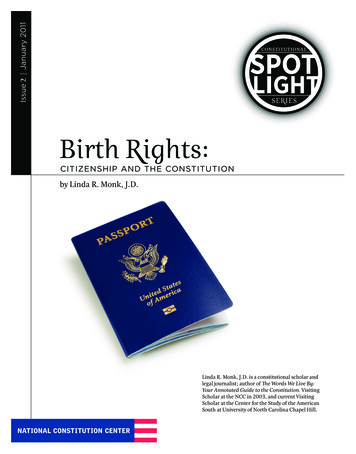
Transcription
Issue 2 January 2011Birth Rights:CITIZENSHIP AND THE CONSTITUTIONby Linda R. Monk, J.D.Linda R. Monk, J.D. is a constitutional scholar andlegal journalist; author of The Words We Live By:Your Annotated Guide to the Constitution. VisitingScholar at the NCC in 2003, and current VisitingScholar at the Center for the Study of the AmericanSouth at University of North Carolina Chapel Hill.
Birth Rights:CITIZENSHIP AND THE CONSTITUTIONAll persons born or naturalized in the United States, and subject to the jurisdictionthereof, are citizens of the United States and of the State wherein they reside.–Fourteenth AmendmentDo the children of illegal immigrants automatically become U.S. citizens when born on American soil? Under currentinterpretations of American law, the answer is yes. Since the ratification of the Fourteenth Amendment in 1868, allpersons who are born in the United States become citizens if they are “subject to the jurisdiction thereof.” However,the exact meaning of that phrase has become controversial withthe rising tide of illegal immigration during the past 20 years.Some constitutional scholarsSome constitutional scholars argue that the intent of the authorsof the Citizenship Clause of the Fourteenth Amendment was notargue that the intent of theto include children born to illegal immigrants; others say that itsauthors of the Citizenshiplegislative history is mixed. The U. S. Supreme Court has neverClause of the Fourteenthruled explicitly on whether the Citizenship Clause applies toAmendment was not tounauthorized immigrants.include children born to illegalSome state legislators as well as members of Congress advocateimmigrants; others say that itsmeasures to end birthright citizenship for children of illegalimmigrants. They argue that automatic citizenship for so-calledlegislative history is mixed.“anchor babies” (a term many immigrants find offensive) providesincentives for illegal immigration because these children oftenqualify for social services and offer their parents a legal tie to the United States that may factor into proposed amnestyprograms. U. S. Senator Lindsey Graham of South Carolina has called birthright citizenship a “mistake” that shouldbe corrected by a constitutional amendment.1In Arizona and other states, legislators are proposing to deny state-issued birth certificates to children of illegalimmigrants, hoping to spark a Supreme Court challenge.2 After sweeping victories in state legislatures duringNovember 2010, Republicans have won their largest representation at that level since the 1930s.3 Many of thesecandidates ran on a platform of increasing penalties for illegal immigration, some of which included removingbirthright citizenship. In addition to Arizona, legislators in the states of Pennsylvania, Georgia, South Carolina,Mississippi, Oklahoma, and Nebraska will sponsor bills to restrict birthright citizenship for children of illegalimmigrants, in some cases by issuing different birth certificates for children born to legal versus illegal immigrants.4“The federal government’s failure to enforce our border has functionally turned every state into a border state,”according to state representative Randy Terrill, a Republican in Oklahoma. “This is federalism in action,” he added.“The states are stepping in and filling the void left by the federal government.”5Other political leaders decry plans to end a definition of birthright citizenship they believe is enshrined in theFourteenth Amendment. Whether such change requires a mere statute or a constitutional amendment is a hotlydebated question that may appear before the U.S. Supreme Court.CONSTITUTIONAL SPOTLIGHT SERIES Birth Rights: Citizenship and the Constitution3
Illegal Immigration by the NumbersAccording to the Pew Hispanic Center, the United States faced a record-breaking wave of illegal immigration from1990 to 2008–increasing almost three-fold from a total population of 3.5 million unauthorized immigrants to 11.9million.6 These statistics were based on figures from the U.S. Census, which indicates foreign-born status but doesnot determine immigration status. The Pew Hispanic Center then adjusts these figures by subtracting an estimate ofthe number of foreign-born residents lawfully in the United States.7Based on the most recent figures, which are from March 2009, the Pew Hispanic Center reported thefollowing general trends: For the first time in two decades, the total number of illegal immigrants has dropped significantly,from a high of 12 million in 2007 to 11.1 million in 2009.8 The average annual number of new illegal immigrants fell dramatically, from 850,000 in March2005 to 300,000 in March 2009.9 Mexico remains the primary source of illegal immigration, with 60 percent; other Latin Americannations represent 20 percent; and South and East Asia have 11 percent.10Unauthorized immigrants are younger and have a higher birthrate than the general U.S. population.11 Although illegalimmigrants are only 4 percent of all adults, their children represent 8 percent of all newborns, as of March 2009.12This figure includes children who have only one illegal immigrant as a parent (the other parent may be a U.S. citizen ora legal resident). About 4 million children under the age of 18 as of 2009 have illegal immigrants as parents but wereborn in the United States; another 1.1 million children are illegal immigrants themselves.13 Couples with childrenare only 21 percent of U.S.-born households, but 45 percent of households of unauthorized immigrants.14 About 37percent of adult illegal immigrants are parents of children born in the United States, a rate that has remained constantsince 2003.15Given these statistics, some elected leaders argue that changing automatic birthright citizenship would help stemthe tide of illegal immigration by reducing the incentives for such migrants to have children. Yet Chicago Tribunecolumnist Steve Chapman disagrees: hy are all these undocumented foreigners producing offspring on U.S. soil, if not because of birthright citizenship? WSome obvious explanations: Because they live here, and because they tend to be of childbearing age, since olderfolks are less likely to trek through the desert for the privilege of harvesting watermelons. ut the chief reason is that having kids is what human beings do, wherever they are and whatever their Bimmigration status. The odd thing would be if these newcomers weren’t reproducing.16In addition, a change in the definition of birthright citizenship would not likely apply to children who are born in theUnited States to a U.S. citizen. Such children would normally be considered U.S. citizens, regardless of the immigrationstatus of the other parent. And according to the Migration Policy Institute, a change in birthright citizenship would onlyincrease the numbers of illegal immigrants by denying legal status to new generations of persons born in the UnitedStates. Said Michael Fix, author of an MPI study on such changes: “This perpetuation of hereditary disadvantage basedon the legal status of one’s ancestors would be unprecedented in U.S. immigration law.”16When Did Immigration Become Illegal?For much of U.S. history, there were no legal limits on immigration, although rules for naturalization varied. Duringthe colonial era, the English colonies in North America took land from Native Americans by both treaty and conquest,and then sought to attract other European immigrants as settlers.The colonial charters of Virginia and Maryland, for example, allowedFor much of U.S. history,government officials to admit and give property rights to “strangersthere were no legal limits onand aliens.”18 In some colonies, governors and legislators naturalizedentire groups of settlers by statute. In 1740 Parliament passed a law that immigration, although rules ofenabled aliens who had lived in the colonies for seven years to becomenaturalization varied.English subjects–if they were not Catholics.194CONSTITUTIONAL SPOTLIGHT SERIES Birth Rights: Citizenship and the Constitution
But after a massive influx of immigrants to the colonies when the Seven Years’ War ended, Parliament began to limitthe authority of the colonies to authorize special naturalizations in 1773. Such was the outcry that the nascent UnitedStates cited this injustice in the Declaration of Independence: “He has endeavoured to prevent the population of theseStates; for that purpose obstructing the Laws for Naturalization of Foreigners; refusing to pass others to encouragetheir migrations hither, and raising the conditions of new Appropriations of Lands.” Most of the immigrants duringthe colonial era came from England, although other European nations were also included. Many of the Englishimmigrants were indentured servants, including those forcibly sent to America under vagrancy and poor laws.Immigration became a fierce issue again during the Federalist era. Political parties emerged for the first time, asthe new nation began to function under the U. S. Constitution in 1789. Democratic-Republicans, led by ThomasJefferson, supported the rights of new immigrants, and the Federalists, led by President John Adams, feared thatsuch immigrants were becoming citizens (and voters) too soon. In 1798, the Federalist Congress passed the Alienand Sedition Acts, which extended the required residency for citizenship of a “free white person”20 from five years tofourteen years.21 These laws were so unpopular that they contributed to the election of Jefferson as president in 1800.Three other large waves of immigrants have come to the United States since the nation’s founding. From 1820 to the1870s, about one-third of the immigrants were Irish and another one-third were German. The opening of lands to thewest of the Mississippi, accompanied by decimation of the Indian nations, created new opportunities for settlementby Europeans. Also, the gold rush in California led to a significant influx of Chinese immigrants, along with a treatybetween the United States and China that allowed the importation of Chinese laborers.Another wave occurred between 1880 and 1920, with immigrants traveling from Italy, Scandinavia, and EasternEurope. But during this time the United States also passed its first laws to restrict immigration, the Page Act in 187522and the Chinese Exclusion Act in 1882. The Page Act forbade the importation of convicts and prostitutes, as well asinvoluntary laborers from Asian countries. The Chinese Exclusion Act ended virtually all immigration from China,and it prohibited Chinese resident aliens from becoming U. S. citizens–a restriction not removed until 1943.23Another wave of immigration has been arriving in the United States since the 1980s, coming chiefly from LatinAmerica. At that point, the number of foreign-born U. S. residents (including naturalized citizens, legal residents,and illegal immigrants) exceeded the previous high during the 1930s.24 The most recent census figures from 2009also put the percentage of foreign-born U.S. residents at 12.9 percent,25 approaching the all-time high of 14.8 percentin 1890.26 The United States accepts more legal immigrants than all other nations combined.The Constitution and CitizenshipThe U.S. Constitution did not define citizenship when it was writtenin 1787, although it refers to the term several times. Rather, each ofthe thirteen states had its own rules for citizenship in that state, whichthen formed the basis of national citizenship. A person could not be acitizen of the national government without first being a citizen of a state.Congress did pass certain laws regulating residency requirements forbecoming a naturalized citizen, but these did not supplant other criteriaissued by the states. Not until the Supreme Court’s Dred Scott decisionin 1857 did a clear definition of national citizenship emerge, one thatspecifically excluded African Americans–both slave and free.The U.S. Constitution didnot define citizenship whenit was written in 1787,although it refers to theterm several times.In the sectional crisis that divided America before the Civil War, the states fiercely disagreed about the legal status ofslaves. Northern states, which had abolished slavery, sought to prevent slavery from expanding into the newly createdwestern states formed from the Louisiana Purchase. Southern states feared that slavery would be abolished outrightif free states came to outnumber slaveholding states. But under the Missouri Compromise of 1820, slavery wasprohibited in any future states created north of Missouri.CONSTITUTIONAL SPOTLIGHT SERIES Birth Rights: Citizenship and the Constitution5
Dred Scott, who had been born a slave in Virginia, filed a lawsuit in 1847 to seek freedom for himself, his wife, and histwo daughters, because they had temporarily been taken from the slaveholding state of Missouri into free territory.When the U.S. Supreme Court finally considered Scott’s appeal in 1857, President James Buchanan actively lobbiedmembers of the Court to intercede–hoping a legal ruling would end the political conflict over slavery and avertbloodshed.27 But his interference backfired.Chief Justice Roger Taney’s decision did favor the rights of slaveholders, holding that under the Fifth AmendmentCongress had no power to deprive them of their “property” in slaves by abolishing slavery in the federal territories.In the process of doing so, Taney first declared that as a slave Dred Scott was not a U. S. citizen, and could not bring alawsuit in federal court. Moreover, held Taney, an African American could never be a U.S. citizen, whether slave or free: hey had for more than a century before been regarded as beings of an inferior order, and altogether unfit toTassociate with the white race, either in social or political relations; and so far inferior, that they had no rights which the white man was bound to respect; and that the negro might justly and lawfully be reduced to slavery for his benefit.28But Justice Benjamin R. Curtis disputed Taney’s definition of citizenship under the Constitution. He argued that a“natural born citizen,” as referred to within the document, was to be defined by the states: o determine whether any free persons, descended from Africans held in slavery, were citizens of the United StatesTunder the Confederation, and consequently at the time of the adoption of the Constitution of the United States, it is only necessary to know whether any such persons were citizens of either of the States under the Confederation,at the time of the adoption of the Constitution. f this there can be no doubt. At the time of the ratification of the Articles of Confederation, all free native-born Oinhabitants of the States of New Hampshire, Massachusetts, New York, New Jersey, and North Carolina, thoughdescended from African slaves, were not only citizens of those States, but such of them as had the other necessaryqualifications possessed the franchise of electors, on equal terms with other citizens. . . .I can find nothing in the Constitution which . . . deprives of their citizenship any class of persons who were citizens ofthe United States at the time of its adoption, or who should be native-born citizens of any State after its adoption;nor any power enabling Congress to disfranchise persons born on the soil of any State, and entitled to citizenship ofsuch State by its Constitution and laws. And my opinion is, that, under the Constitution of the United States, everyfree person born on the soil of a State, who is a citizen of that State by force of its Constitution or laws, is also acitizen of the United States.29The national outcry against the Dred Scott ruling was immediate and intense. By overturning the MissouriCompromise, the Court had sided entirely with slaveholders and made political compromise on the issue impossible.Slaves were to be held wherever slaveholders wanted to take them, so there was no such thing as free territoryanymore. The Union could not hold. Out of that firestorm arose the Civil War, from which emerged the FourteenthAmendment. It added to the Constitution, for the first time, a definition of both national and state citizenship.6CONSTITUTIONAL SPOTLIGHT SERIES Birth Rights: Citizenship and the Constitution
The Creation of the Fourteenth AmendmentThe Constitution “was widely read in the antebellum era as makingThe Fourteenth Amendmentnational citizenship derivative of state citizenship, except in casesnationalized the definition ofinvolving the naturalization of immigrants and the regulation ofcitizenship, rather than relyingfederal territories.”30 The Fourteenth Amendment nationalized theon the states, and it made statedefinition of citizenship, rather than relying on the states, and itmade state citizenship automatic upon residence in that state. Under citizenship automatic uponthe Fourteenth Amendment, all persons “born or naturalized” in theresidence in that state.United States and “subject to the jurisdiction thereof” are citizens ofboth the state in which they reside and the United States. Ratified in1868, the Fourteenth Amendment was intended to overturn the Dred Scott ruling and protect former slaves, whowere not recognized as citizens by Southern states even after the Civil War and emancipation.At first, the Reconstruction Congress had tried to create a statutory definition of citizenship under the Civil Rights Actof 1866: “All persons born in the United States and not subject to any foreign power, excluding Indians not taxed, arehereby declared to be citizens of the United States.” President Andrew Johnson, who opposed the Radical Republicansin Congress, vetoed the measure: y the first section of the bill all persons born in the United States, and not subject to any foreign power, excludingBIndians not taxed, are declared to be citizens of the United States. This provision comprehends the Chinese of thePacific states, Indians subject to taxation, the people called gypsies, as well as the entire race designated as blacks,persons of color, negroes, mulattoes, and persons of African blood. Every individual of those races, born in theUnited States, is, by the bill, made a citizen of the United States.31Congress overrode Johnson’s veto of the bill. But fearing that the Supreme Court might strike down such a law asunconstitutional, Congress moved forward on a proposed Fourteenth Amendment that would accomplish the samegoal. Rep. John Bingham, the principal author of the Fourteenth Amendment, had not included a definition ofcitizenship in his original language. But, according to historian Rebecca Zeitlow, “The Citizenship Clause was addedduring the debate over the [proposed amendment] in order to reinforce the Citizenship Clause of the 1866 Civil RightsAct and to ensure that Dred Scott was overruled.”32However, in a series of revisions in the Senate the Citizenship Clause was altered and its intention became unclear.Some legislators believed that the amendment’s new phrase, “subject to the jurisdiction thereof,” meant exactly thesame thing as the language in the Civil Rights Act: “not subject to any foreign power.” Senators Lyman Trumbullof Illinois and Reverdy Johnson of Maryland were very explicit on this issue. Said Trumbull: “What do we meanby ‘subject to the jurisdiction of the United States’? Not owing allegiance to anybody else; that is what it means.”33Added Senator Johnson: “Now, all that this amendment provides is that all persons born within the United States,and not subject to some foreign power–for that, no doubt, is the meaning of the committee who have brought thematter before us–shall be considered as citizens of the United States.”34When he introduced the proposed Citizenship Clause, Senator Jacob Howard of Michigan explained its intent:“ Every person born within the limits of the United States, and subject to their jurisdiction, is by virtue of natural lawand national law a citizen of the United States. This will not, of course, include persons born in the United Stateswho are foreigners, aliens, who belong to the families of ambassadors or foreign ministers accredited to the Government of the United States, but will include every other class of persons. It settles the great question of citizenship and removes all doubt as to what persons are or are not citizens of the United States. This has longbeen a great desideratum in the jurisprudence and legislation of this country.”35CONSTITUTIONAL SPOTLIGHT SERIES Birth Rights: Citizenship and the Constitution7
Senator Willard Saulsbury of Delaware stated flatly that the Citizenship Clause’s object was “simply to declarethat Negroes shall be citizens of the United States.”36 But Senator Edgar Cowan of Pennsylvania asked whetherthe amendment would also make citizens of the children of Chinese immigrants in California or a “Gypsy born inPennsylvania.”37 Senator John Conness of California–himself an Irish immigrant–spoke in favor of that proposition,arguing that his state had already allowed Chinese immigrants to become citizens and their numbers were quitesmall.38 Cowan was not persuaded. He added that a foreigner “has a right to the protection of the laws; but he is nota citizen in the ordinary acceptation of the word.”39The one consistent theme in the legislative debate was to ensure that “Indians not taxed” were ineligible forcitizenship under the new language of the Fourteenth Amendment. Related to that point, several senators remarkedthat U.S. jurisdiction over the birthright citizens would have to be complete and total–unlike that over Indian tribes.Another senator pointed out that children of diplomats similarly were not subject to the full jurisdiction of the UnitedStates.40 Beyond its application to Indians, the legislative history regarding the intent of the Citizenship Clause wassomewhat mixed, leaving the Supreme Court to determine its construction.Citizenship in the CourtsIn the Slaughterhouse Cases (1873), the Supreme Court first interpretedthe Citizenship Clause of the Fourteenth Amendment. It ruled that“[t]he phrase ‘subject to its jurisdiction’ was intended to exclude fromits operation children of ministers, consuls, and citizens or subjects offoreign States born within the United States.”41 And inElk v. Wilkins (1884), the Court held that the Citizenship Clause didnot apply to Indians who were born in the United States as part of atribe, even if they subsequently left the tribe. Such Native Americanscould only become naturalized citizens, through a treaty or legislation.Said the Court: “no one can become a citizen of a nation without itsconsent.”42 The Court emphasized the meaning of the phrase “subject tothe jurisdiction thereof”: “The evident meaning of these last words is notmerely subject in some respect or degree to the jurisdiction of the UnitedStates, but completely subject to their political jurisdiction and owingthem direct and immediate allegiance.”43The Court emphasizedthe meaning of the phrase“subject to the jurisdictionthereof”: “The evidentmeaning of these last wordsis not merely subject insome respect or degree tothe jurisdiction of the UnitedStates, but completelysubject to their politicaljurisdiction and owingthem direct and immediateallegiance.”43But in United States v. Wong Kim Ark (1898)44, the Supreme Courtapplied British common law (or customary law) to interpret theCitizenship Clause of the Fourteenth Amendment. The Court ruled that a “natural born citizen,” as mentioned in theU.S. Constitution, must be interpreted according to the standards set forth in an English ruling known as Calvin’sCase (1608)45. Under feudal law, children of friendly aliens owed allegiance to the sovereign in whose dominion theywere born. This principle is known as jus solis (law of soil), in which citizenship attaches through the land in whichone is born. The complementary principle of jus sanguinis (law of blood) extends citizenship through the nationalityof a child’s parents.Although these principles were nowhere mentioned in the legislative history of the Fourteenth Amendment, theSupreme Court ruled that Wong Kim Ark, born in the United States to Chinese immigrants, had acquired birthrightcitizenship. The Court acknowledged that Ark’s parents were still subjects of the Chinese Emperor, and that Arkwas a laborer otherwise ineligible for U.S. citizenship under the Chinese Exclusion Act. However, Ark’s parents hadestablished a permanent domicile and legal residence in San Francisco, where he was born.Moreover, the Court held that the only purpose of the Fourteenth Amendment’s limiting phrase, “subject to thejurisdiction thereof,” was to acknowledge the two exceptions to birthright citizenship recognized under common law.These were children born to foreign ambassadors or occupying enemies. Indians, said the Court, occupied a specialcategory not recognized by common law.8CONSTITUTIONAL SPOTLIGHT SERIES Birth Rights: Citizenship and the Constitution
The dissenting justices totally rejected the Court’s reasoning: he framers of the Constitution were familiar with the distinctions between the Roman law and the feudal law,Tbetween obligations based on territoriality and those based on the personal and invisible character of origin; andthere is nothing to show that in the matter of nationality they intended to adhere to principles derived from regalgovernment, which they had just assisted in overthrowing.46In addition, they pointed out that under the Court’s reasoning, no childof American citizens born abroad could become a U.S. citizen withoutfirst being naturalized, as place of birth was the only relevant factor.Furthermore, Congress would have absolutely no power to excludeany alien born on U.S. soil. The Court’s interpretation of birthrightcitizenship, said the dissent, undermined Congress’s constitutionalauthority to regulate naturalization.The Supreme Court has notdirectly addressed the questionof whether the children ofillegal immigrants are eligiblefor birthright citizenship underthe Fourteenth Amendment.The Supreme Court has not directly addressed the question of whetherthe children of illegal immigrants are eligible for birthright citizenshipunder the Fourteenth Amendment. In INS v. Rios-Pineda (1985), theCourt said in dicta, or language not directly part of the holding in the case, that children born in the United Statesto illegal immigrants are citizens.47 The Court did rule in Plyler v. Doe (1983)48 that another part of the FourteenthAmendment, the Equal Protection Clause, does apply to illegal immigrants because they are “persons within thejurisdiction” of a state. This is a different legal standard than that used for the Citizenship Clause.An Amendment or a Statute?Due to the large numbers of illegal immigrants in the United States, some political leaders are proposing to removebirthright citizenship as an automatic right. Other Western nations have acted similarly when faced by unwantedimmigration: Portugal in 1981; United Kingdom in 1983; India in 1987; France in 1993; Ireland in 2005; NewZealand in 2006; and Australia in 2007. Currently among developed nations only the United States and Canada haveautomatic birthright citizenship for children of illegal immigrants.49Certain businesses even promote a “birth tourism” industry designed for pregnant women to travel to the UnitedStates on tourist visas and give birth to their children. These women believe that their children, as American citizens,may one day have greater educational opportunity if they decide to leave their native country. Although the exactnumbers of such women are unknown, some hotels are creating special package deals to attract “birth tourism” totheir establishments.50Judge Richard Posner, a prominent conservative federal judge, has spoken out against such practices: e should not be encouraging foreigners to come to the United States solely to enable them to confer U.S.Wcitizenship on their future children. But the way to stop that abuse of hospitality is to remove the incentive bychanging the rule on citizenship. . . . A constitutional amendment may be required to change the rule wherebybirth in this country automatically confers U.S. citizenship, but I doubt it. . . . The purpose of the rule was to grantcitizenship to the recently freed slaves, and the exception for children of foreign diplomats and heads of state showsthat Congress does not read the Citizenship Clause of the Fourteenth Amendment literally. Congress would not beflouting the Constitution if it amended the Immigration and Nationality Act to put an end to the nonsense.51Rep. Ron Paul (R-TX) and others have introduced legislation to address this issue. Paul sponsored a proposedconstitutional amendment that would deny citizenship to children born in the United States whose parents arenot citizens or permanent residents. Another proposal is to amend the Immigration and Nationality Act to restrictbirthright citizenship to children of mothers who are citizens or legal residents of the United States. With the newRepublican majority in the House of Representatives in 2011, such measures may receive more legislative attention.CONSTITUTIONAL SPOTLIGHT SERIES Birth Rights: Citizenship and the Constitution9
Other legislation passed by the states to restrict illegal immigration is already wending its way through the U.S. courtsystem. The federal court for the Ninth Circuit heard arguments in November 2010 about an Arizona law that requiredlaw enforcement officers to ask about immigration status of offenders when they had “reasonable suspicion” tobelieve the person might be an illegal immigrant. “States will push ahead regardless of the Ninth Circuit,” accordingto Kris Kobach, a Kansas law professor and state official who has helped draft many state immigrationlaws. According to Kobach, “A lot of people recognize that [a] judge’s decision is very much open to dispute.”52Similarly, the U. S. Supreme Court may be for
born in the United States; another 1.1 million children are illegal immigrants themselves.13 Couples with children are only 21 percent of U.S.-born households, but 45 percent of households of unauthorized immigrants.14 About 37 percent of adult illegal immigrants are parents of children born
